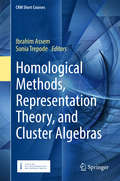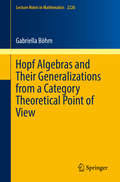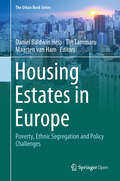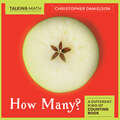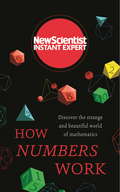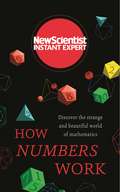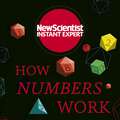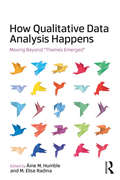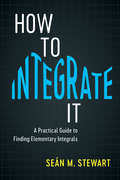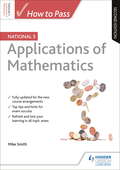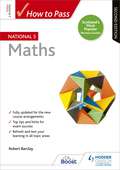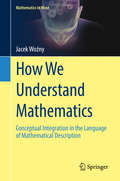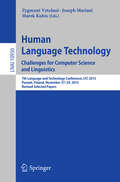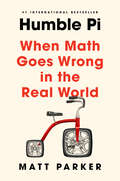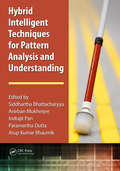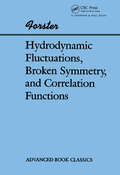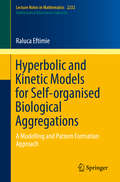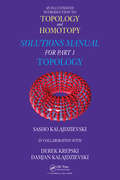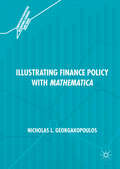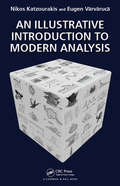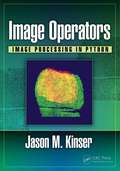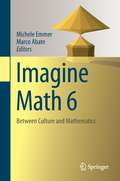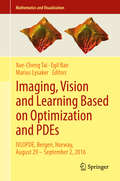- Table View
- List View
Homological Methods, Representation Theory, and Cluster Algebras (Crm Short Courses Ser.)
by Ibrahim Assem Sonia TrepodeThis text presents six mini-courses, all devoted to interactions between representation theory of algebras, homological algebra, and the new ever-expanding theory of cluster algebras. The interplay between the topics discussed in this text will continue to grow and this collection of courses stands as a partial testimony to this new development. The courses are useful for any mathematician who would like to learn more about this rapidly developing field; the primary aim is to engage graduate students and young researchers. Prerequisites include knowledge of some noncommutative algebra or homological algebra. Homological algebra has always been considered as one of the main tools in the study of finite-dimensional algebras. The strong relationship with cluster algebras is more recent and has quickly established itself as one of the important highlights of today’s mathematical landscape. This connection has been fruitful to both areas—representation theory provides a categorification of cluster algebras, while the study of cluster algebras provides representation theory with new objects of study.The six mini-courses comprising this text were delivered March 7–18, 2016 at a CIMPA (Centre International de Mathématiques Pures et Appliquées) research school held at the Universidad Nacional de Mar del Plata, Argentina. This research school was dedicated to the founder of the Argentinian research group in representation theory, M.I. Platzeck.The courses held were:Advanced homological algebraIntroduction to the representation theory of algebrasAuslander-Reiten theory for algebras of infinite representation typeCluster algebras arising from surfacesCluster tilted algebrasCluster charactersIntroduction to K-theoryBrauer graph algebras and applications to cluster algebras
Hopf Algebras and Their Generalizations from a Category Theoretical Point of View (Lecture Notes in Mathematics #2226)
by Gabriella BöhmThese lecture notes provide a self-contained introduction to a wide range of generalizations of Hopf algebras. Multiplication of their modules is described by replacing the category of vector spaces with more general monoidal categories, thereby extending the range of applications. Since Sweedler's work in the 1960s, Hopf algebras have earned a noble place in the garden of mathematical structures. Their use is well accepted in fundamental areas such as algebraic geometry, representation theory, algebraic topology, and combinatorics. Now, similar to having moved from groups to groupoids, it is becoming clear that generalizations of Hopf algebras must also be considered. This book offers a unified description of Hopf algebras and their generalizations from a category theoretical point of view. The author applies the theory of liftings to Eilenberg–Moore categories to translate the axioms of each considered variant of a bialgebra (or Hopf algebra) to a bimonad (or Hopf monad) structure on a suitable functor. Covered structures include bialgebroids over arbitrary algebras, in particular weak bialgebras, and bimonoids in duoidal categories, such as bialgebras over commutative rings, semi-Hopf group algebras, small categories, and categories enriched in coalgebras. Graduate students and researchers in algebra and category theory will find this book particularly useful. Including a wide range of illustrative examples, numerous exercises, and completely worked solutions, it is suitable for self-study.
Housing Estates in Europe: Poverty, Ethnic Segregation And Policy Challenges (The Urban Book Series)
by Daniel Baldwin Hess Tiit Tammaru Maarten Van HamThis open access book explores the formation and socio-spatial trajectories of large housing estates in Europe. Are these estates clustered or scattered? Which social groups originally had access to residential space in housing estates? What is the size, scale and geography of housing estates, their architectural and built environment composition, services and neighbourhood amenities, and metropolitan connectivity? How do housing estates contribute to the urban mosaic of neighborhoods by ethnic and socio-economic status? What types of policies and planning initiatives have been implemented in order to prevent the social downgrading of housing estates?The collection of chapters in this book addresses these questions from a new perspective previously unexplored in scholarly literature. The social aspects of housing estates are thoroughly investigated (including socio-demographic and economic characteristics of current and past inhabitants; ethnicity and segregation patterns; population dynamics; etc.), and the physical composition of housing estates is described in significant detail (including building materials; building form; architectural and landscape design; built environment characteristics; etc.). This book is timely because the recent global economic crisis and Europe’s immigration crisis demand a thorough investigation of the role large housing estates play in poverty and ethnic concentration. Through case studies of housing estates in 14 European centers, the book also identifies policy measures that have been used to address challenges in housing estates throughout Europe.
How Many? (Talking Math Ser.)
by Christopher DanielsonTalking math with your child is fun and easy with this better approach to counting!Written by a math educator, this innovative book encourages critical thinking and sparks memorable mathematical conversations. You and your child decide what to count on each page. You have many choices, and the longer you look, the more possibilities you'll notice. There are no wrong answers in this book. As long as you're talking about what you see, think, and wonder, you're talking math!
How Numbers Work: Discover the strange and beautiful world of mathematics (New Scientist Instant Expert Ser.)
by New ScientistThink of a number between one and ten. No, hang on, let's make this interesting. Between zero and infinity. Even if you stick to the whole numbers, there are a lot to choose from - an infinite number in fact. Throw in decimal fractions and infinity suddenly gets an awful lot bigger (is that even possible?) And then there are the negative numbers, the imaginary numbers, the irrational numbers like pi which never end. It literally never ends. <P><P>The world of numbers is indeed strange and beautiful. Among its inhabitants are some really notable characters - pi, e, the "imaginary" number i and the famous golden ratio to name just a few. Prime numbers occupy a special status. Zero is very odd indeed: is it a number, or isn't it? <P><P>How Numbers Work takes a tour of this mind-blowing but beautiful realm of numbers and the mathematical rules that connect them. Not only that, but take a crash course on the biggest unsolved problems that keep mathematicians up at night, find out about the strange and unexpected ways mathematics influences our everyday lives, and discover the incredible connection between numbers and reality itself. <P><P>ABOUT THE SERIES <P><P>New Scientist Instant Expert books are definitive and accessible entry points to the most important subjects in science; subjects that challenge, attract debate, invite controversy and engage the most enquiring minds. Designed for curious readers who want to know how things work and why, the Instant Expert series explores the topics that really matter and their impact on individuals, society, and the planet, translating the scientific complexities around us into language that's open to everyone, and putting new ideas and discoveries into perspective and context.
How Numbers Work: Discover the strange and beautiful world of mathematics (Instant Expert)
by New ScientistThink of a number between one and tenNo, hang on, let's make this interesting. Between zero and infinity. Even if you stick to the whole numbers, there are a lot to choose from - an infinite number in fact. Throw in decimal fractions and infinity suddenly gets an awful lot bigger (is that even possible?) And then there are the negative numbers, the imaginary numbers, the irrational numbers like p which never end. It literally never ends.The world of numbers is indeed strange and beautiful. Among its inhabitants are some really notable characters - pi, e, the square root of minus two and the famous golden ratio to name just a few. Prime numbers occupy a special status. Zero is very odd indeed. And even some apparently common-or-garden integers such as 37 have special properties. Adventures In Mathematics takes a tour of this mind-blowing but beautiful world of numbers and the mathematical rules that connect them. Find out mathematicians' favourite numbers, and the ones they are afraid of (spoiler: it isn't 13). Discover the incredible connection between numbers and the rules of nature. And learn some amazing mathematical tricks that will keep you amused for hours.
How Numbers Work: Discover the strange and beautiful world of mathematics (New Scientist Instant Expert)
by New ScientistHow Numbers Work is a tour of the mind-blowing but beautiful realm of numbers and the mathematical rules that connect them.Think of a number between one and ten. No, hang on, let's make this interesting. Between zero and infinity. Even if you stick to the whole numbers, there are a lot to choose from - an infinite number in fact. Throw in decimal fractions and infinity suddenly gets an awful lot bigger (is that even possible?) And then there are the negative numbers, the imaginary numbers, the irrational numbers like pi which never end. It literally never ends.The world of numbers is indeed strange and beautiful. Among its inhabitants are some really notable characters - pi, e, the "imaginary" number i and the famous golden ratio to name just a few. Prime numbers occupy a special status. Zero is very odd indeed: is it a number, or isn't it?How Numbers Work takes a tour of this mind-blowing but beautiful realm of numbers and the mathematical rules that connect them. Not only that, but take a crash course on the biggest unsolved problems that keep mathematicians up at night, find out about the strange and unexpected ways mathematics influences our everyday lives, and discover the incredible connection between numbers and reality itself. ABOUT THE SERIESNew Scientist Instant Expert books are definitive and accessible entry points to the most important subjects in science; subjects that challenge, attract debate, invite controversy and engage the most enquiring minds. Designed for curious readers who want to know how things work and why, the Instant Expert series explores the topics that really matter and their impact on individuals, society, and the planet, translating the scientific complexities around us into language that's open to everyone, and putting new ideas and discoveries into perspective and context.(P)2018 Hodder & Stoughton Limited
How Qualitative Data Analysis Happens: Moving Beyond "Themes Emerged"
by Áine Humble Elise RadinaWinner of the 2020 Anselm Strauss Award for Qualitative Family Research, National Council on Family Relations. How is qualitative data actually collected, analyzed, and accomplished? Real stories of How Qualitative Data Analysis Occurs: Moving Beyond "Themes Emerged" offers an in-depth look into how qualitative social science researchers studying family issues and dynamics approach their data analyses. It moves beyond the usual vague statement of "themes emerged from the data" to show readers how researchers actively and consciously arrive at their themes and conclusions, revealing the complexity and time involved in making sense of thousands of pages of interview data, multiple data sources, and diverse types of data. How Qualitative Data Analysis Occurs focuses on a diversity of topics in family research across the life course. The various authors provide detailed narratives into how they analyzed their data from previous publications, and what methodologies they used, ranging from arts-based research, autoethnography, community-based participatory research, ethnography, grounded theory, to narrative analysis. Supplemental figures, images, and screenshots which are referred to in the chapters, are included in an accompanying eResource, as well as links to the previously published work on which the chapters are based. This book is an invaluable resource for experienced and novice qualitative researchers throughout the social sciences.
How to Integrate It: A Practical Guide to Finding Elementary Integers
by Seán M. StewartWhile differentiating elementary functions is merely a skill, finding their integrals is an art. This practical introduction to the art of integration gives readers the tools and confidence to tackle common and uncommon integrals. After a review of the basic properties of the Riemann integral, each chapter is devoted to a particular technique of elementary integration. Thorough explanations and plentiful worked examples prepare the reader for the extensive exercises at the end of each chapter. These exercises increase in difficulty from warm-up problems, through drill examples, to challenging extensions which illustrate such advanced topics as the irrationality of π and e, the solution of the Basel problem, Leibniz's series and Wallis's product. The author's accessible and engaging manner will appeal to a wide audience, including students, teachers and self-learners. The book can serve as a complete introduction to finding elementary integrals, or as a supplementary text for any beginning course in calculus. A systematic introduction to integration, containing many fully worked examples to demonstrate how the techniques are applied in practice Contains more than 500 exercises ranging in difficulty, from warm-ups to challenging extensions Accessible and engaging, this book will be of interest to students, teachers and self-learners.
How to Pass National 5 Applications of Maths: Second Edition Ebook
by Mike SmithExam Board: SQALevel: National 5Subject: MathsFirst Teaching: August 2017First Exam: May 2018Get your best grade with How to Pass National 5 Applications of Mathematics.Fully updated to account for the changes to the National 5 exam, this book contains all the advice and support you need to revise successfully. It combines an overview of the course syllabus with advice from a top expert on how to improve exam performance, so you have the best chance of success.- Refresh your knowledge with complete course notes- Prepare for the exam with top tips and hints on revision technique- Get your best grade with advice on how to gain those vital extra marks
How to Pass National 5 Applications of Maths, Second Edition
by Mike SmithExam Board: SQALevel: National 5Subject: MathsFirst Teaching: September 2017First Exam: Summer 2018Get your best grade with How to Pass National 5 Applications of Mathematics.Fully updated to account for the changes to the National 5 exam, this book contains all the advice and support you need to revise successfully. It combines an overview of the course syllabus with advice from a top expert on how to improve exam performance, so you have the best chance of success.- Refresh your knowledge with complete course notes- Prepare for the exam with top tips and hints on revision technique- Get your best grade with advice on how to gain those vital extra marks
How to Pass National 5 Maths, Second Edition
by Robert BarclayExam Board: SQALevel: National 5Subject: MathsFirst teaching: September 2017First exams: Summer 2018Get your best grade with comprehensive course notes and advice from Scotland's top experts, fully updated for the latest changes to the National 5 course specification.How to Pass National 5 Maths, Second Edition contains all the advice and support you need to revise successfully for your National 5 exam. It combines an overview of the course syllabus with advice from a top expert on how to improve exam performance, so you have the best chance of success.> Revise confidently with up-to-date guidance tailored to the latest assessment changes> Refresh your knowledge with comprehensive, tailored subject notes> Prepare for the exam with top tips and hints on revision techniques> Get your best grade with advice on how to gain those vital extra marks
How to Pass National 5 Maths, Second Edition: Second Edition Epub
by Robert BarclayExam Board: SQALevel: National 5Subject: MathsFirst teaching: September 2017First exams: Summer 2018Get your best grade with comprehensive course notes and advice from Scotland's top experts, fully updated for the latest changes to the National 5 course specification.How to Pass National 5 Maths, Second Edition contains all the advice and support you need to revise successfully for your National 5 exam. It combines an overview of the course syllabus with advice from a top expert on how to improve exam performance, so you have the best chance of success.> Revise confidently with up-to-date guidance tailored to the latest assessment changes> Refresh your knowledge with comprehensive, tailored subject notes> Prepare for the exam with top tips and hints on revision techniques> Get your best grade with advice on how to gain those vital extra marks
How We Understand Mathematics: Conceptual Integration In The Language Of Mathematical Description (Mathematics in Mind)
by Jacek WoźnyThis volume examines mathematics as a product of the human mind and analyzes the language of "pure mathematics" from various advanced-level sources. Through analysis of the foundational texts of mathematics, it is demonstrated that math is a complex literary creation, containing objects, actors, actions, projection, prediction, planning, explanation, evaluation, roles, image schemas, metonymy, conceptual blending, and, of course, (natural) language. The book follows the narrative of mathematics in a typical order of presentation for a standard university-level algebra course, beginning with analysis of set theory and mappings and continuing along a path of increasing complexity. At each stage, primary concepts, axioms, definitions, and proofs will be examined in an effort to unfold the tell-tale traces of the basic human cognitive patterns of story and conceptual blending. This book will be of interest to mathematicians, teachers of mathematics, cognitive scientists, cognitive linguists, and anyone interested in the engaging question of how mathematics works and why it works so well.
Human Language Technology. Challenges for Computer Science and Linguistics: 7th Language and Technology Conference, LTC 2015, Poznań, Poland, November 27-29, 2015, Revised Selected Papers (Lecture Notes in Computer Science #10930)
by Zygmunt Vetulani Joseph Mariani Marek KubisThis book constitutes the refereed proceedings of the 7h Language and Technology Conference: Challenges for Computer Science and Linguistics, LTC 2015, held in Poznan, Poland, in November 2015. The 31 revised papers presented in this volume were carefully reviewed and selected from 108 submissions. The papers selected to this volume belong to various fields of: Speech Processing; Multiword Expressions; Parsing; Language Resources and Tools; Ontologies and Wordnets; Machine Translation; Information and Data Extraction; Text Engineering and Processing; Applications in Language Learning; Emotions, Decisions and Opinions; Less-Resourced Languages.
Humble Pi: When Math Goes Wrong in the Real World
by Matt ParkerAn international bestsellerThe book-length answer to anyone who ever put their hand up in math class and asked, &“When am I ever going to use this in the real world?&” &“Fun, informative, and relentlessly entertaining, Humble Pi is a charming and very readable guide to some of humanity's all-time greatest miscalculations—that also gives you permission to feel a little better about some of your own mistakes.&” —Ryan North, author of How to Invent Everything Our whole world is built on math, from the code running a website to the equations enabling the design of skyscrapers and bridges. Most of the time this math works quietly behind the scenes . . . until it doesn&’t. All sorts of seemingly innocuous mathematical mistakes can have significant consequences. Math is easy to ignore until a misplaced decimal point upends the stock market, a unit conversion error causes a plane to crash, or someone divides by zero and stalls a battleship in the middle of the ocean. Exploring and explaining a litany of glitches, near misses, and mathematical mishaps involving the internet, big data, elections, street signs, lotteries, the Roman Empire, and an Olympic team, Matt Parker uncovers the bizarre ways math trips us up, and what this reveals about its essential place in our world. Getting it wrong has never been more fun.
Hybrid Intelligent Techniques for Pattern Analysis and Understanding
by Siddhartha Bhattacharyya Anirban Mukherjee Indrajit Pan Paramartha Dutta Arup Kumar BhaumikHybrid Intelligent Techniques for Pattern Analysis and Understanding outlines the latest research on the development and application of synergistic approaches to pattern analysis in real-world scenarios. An invaluable resource for lecturers, researchers, and graduates students in computer science and engineering, this book covers a diverse range of hybrid intelligent techniques, including image segmentation, character recognition, human behavioral analysis, hyperspectral data processing, and medical image analysis.
Hydrodynamic Fluctuations, Broken Symmetry, And Correlation Functions (Frontiers in Physics)
by Dieter ForsterFrom the Preface: "The purpose of this book is to present and apply a language and to discuss methods which make it very convenient to exploit such analogies, and which are uniquely suited to describe and explain non-equilibrium phenomena in a rich variety of many-particle systems: the language of time correlation functions and linear response theory."
Hyperbolic and Kinetic Models for Self-organised Biological Aggregations: A Modelling and Pattern Formation Approach (Lecture Notes in Mathematics #2232)
by Raluca EftimieThis book focuses on the spatio-temporal patterns generated by two classes of mathematical models (of hyperbolic and kinetic types) that have been increasingly used in the past several years to describe various biological and ecological communities. Here we combine an overview of various modelling approaches for collective behaviours displayed by individuals/cells/bacteria that interact locally and non-locally, with analytical and numerical mathematical techniques that can be used to investigate the spatio-temporal patterns produced by said individuals/cells/bacteria. Richly illustrated, the book offers a valuable guide for researchers new to the field, and is also suitable as a textbook for senior undergraduate or graduate students in mathematics or related disciplines.
An Illustrated Introduction to Topology and Homotopy Solutions Manual for Part 1 Topology
by Sasho Kalajdzievski Derek Krepski Damjan KalajdzievskiThis solution manual accompanies the first part of the book An Illustrated Introduction toTopology and Homotopy by the same author. Except for a small number of exercises inthe first few sections, we provide solutions of the (228) odd-numbered problemsappearing in first part of the book (Topology). The primary targets of this manual are thestudents of topology. This set is not disjoint from the set of instructors of topologycourses, who may also find this manual useful as a source of examples, exam problems,etc.
Illustrating Finance Policy with Mathematica (Quantitative Perspectives On Behavioral Economics And Finance Ser.)
by Nicholas L. GeorgakopoulosStudents in various disciplines—from law and government to business and health policy—need to understand several quantitative aspects of finance (such as the capital asset pricing model or financial options) and policy analysis (e.g., assessing the weight of probabilistic evidence) but often have little quantitative background. This book illustrates those phenomena and explains how to illustrate them using the powerful visuals that computing can produce. Of particular interest to graduate students and scholars in need of sharper quantitative methods, this book introduces the reader to Mathematica, enables readers to use Mathematica to produce their own illustrations, and places specific emphasis on finance and policy as well as the foundations of probability theory.
An Illustrative Introduction to Modern Analysis
by Nikolaos Katzourakis Eugen VarvarucaAimed primarily at undergraduate level university students, An Illustrative Introduction to Modern Analysis provides an accessible and lucid contemporary account of the fundamental principles of Mathematical Analysis. The themes treated include Metric Spaces, General Topology, Continuity, Completeness, Compactness, Measure Theory, Integration, Lebesgue Spaces, Hilbert Spaces, Banach Spaces, Linear Operators, Weak and Weak* Topologies. Suitable both for classroom use and independent reading, this book is ideal preparation for further study in research areas where a broad mathematical toolbox is required.
Image Operators: Image Processing in Python
by Jason M. KinserFor decades, researchers have been developing algorithms to manipulate and analyze images. From this, a common set of image tools now appear in many high-level programming languages. Consequently, the amount of coding required by a user has significantly lessened over the years. While the libraries for image analysis are coalescing to a common toolkit, the language of image analysis has remained stagnant. Often, textual descriptions of an analytical protocol consume far more real estate than does the computer code required to execute the processes. Furthermore, the textual explanations are sometimes vague or incomplete. This book offers a precise mathematical language for the field of image processing. Defined operators correspond directly to standard library routines, greatly facilitating the translation between mathematical descriptions and computer script. This text is presented with Python 3 examples. This text will provide a unified language for image processing Provides the theoretical foundations with accompanied Python® scripts to precisely describe steps in image processing applications Linkage between scripts and theory through operators will be presented All chapters will contain theories, operator equivalents, examples, Python® codes, and exercises
Imagine Math 6: Between Culture And Mathematics
by Michele Emmer Marco AbateImagine mathematics, imagine with the help of mathematics, imagine new worlds, new geometries, new forms. Imagine building mathematical models that make it possible to manage our world better, imagine combining music, art, poetry, literature, architecture and cinema with mathematics. Imagine the unpredictable and sometimes counterintuitive applications of mathematics in all areas of human endeavour. Imagination and mathematics, imagination and culture, culture and mathematics.This sixth volume in the series begins with a homage to the architect Zaha Hadid, who died on March 31st, 2016, a few weeks before the opening of a large exhibition of her works in Palazzo Franchetti in Venice, where all the Mathematics and Culture conferences have taken place in the last years. A large section of the book is dedicated to literature, narrative and mathematics including a contribution from Simon Singh. It discusses the role of media in mathematics, including museums of science, journals and movies. Mathematics and applications, including blood circulation and preventing crimes using earthquakes, is also addressed, while a section on mathematics and art examines the role of math in design. A large selection presents photos of mathematicians and mathematical objects by Vincent Moncorge. Discussing all topics in a way that is rigorous but captivating, detailed but full of evocations, it offers an all-embracing look at the world of mathematics and culture.
Imaging, Vision and Learning Based on Optimization and PDEs: IVLOPDE, Bergen, Norway, August 29 – September 2, 2016 (Mathematics and Visualization)
by Xue-Cheng Tai Egil Bae Marius LysakerThis volume presents the peer-reviewed proceedings of the international conference Imaging, Vision and Learning Based on Optimization and PDEs (IVLOPDE), held in Bergen, Norway, in August/September 2016. The contributions cover state-of-the-art research on mathematical techniques for image processing, computer vision and machine learning based on optimization and partial differential equations (PDEs). It has become an established paradigm to formulate problems within image processing and computer vision as PDEs, variational problems or finite dimensional optimization problems. This compact yet expressive framework makes it possible to incorporate a range of desired properties of the solutions and to design algorithms based on well-founded mathematical theory. A growing body of research has also approached more general problems within data analysis and machine learning from the same perspective, and demonstrated the advantages over earlier, more established algorithms. This volume will appeal to all mathematicians and computer scientists interested in novel techniques and analytical results for optimization, variational models and PDEs, together with experimental results on applications ranging from early image formation to high-level image and data analysis.
